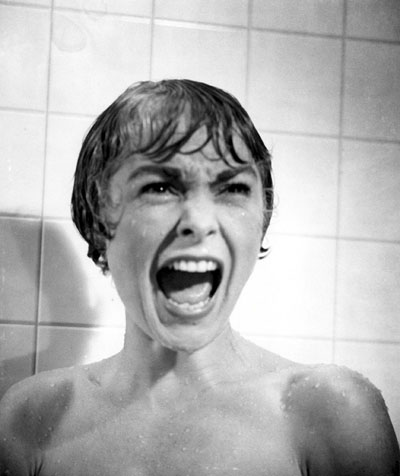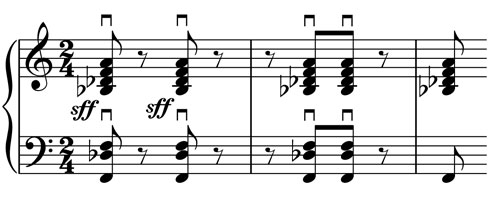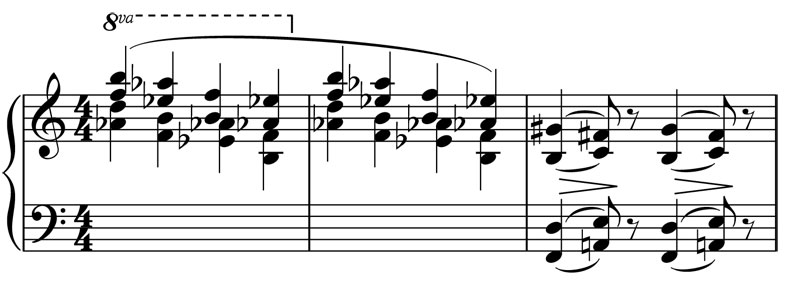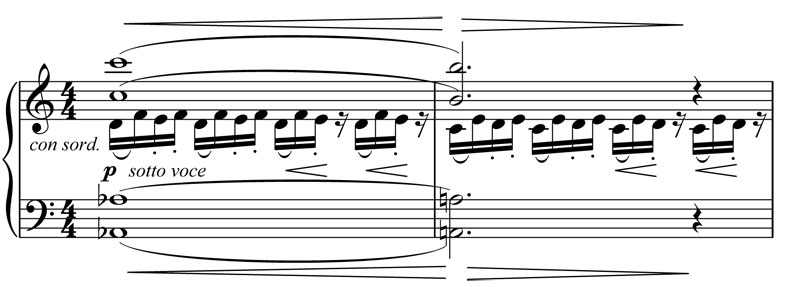
Bernard Herrmann’s score for Alfred Hitchcock’s Psycho is one of the most highly regarded in film history, most of all because the music does so much to create the suspenseful and sometimes terrifying atmosphere of the film. It is surprising, then, that some of the score was not written originally for the film. As Royal S. Brown observes in a film music analysis in his book, Overtones and Undertones,
an entire cue from Psycho (“The Swamp”) was lifted almost note for note from the “Interlude” of a nonfilm-music composition … Herrmann had composed nearly twenty-five years before Psycho, a Sinfonietta (1936) which, like the Psycho score, is for strings only. That Interlude, in fact, contains a three-note motif associated with Norman Bates’s “madness” heard throughout the film. Parts of the Psycho score are taken from other of the Sinfonietta’s five movements as well.
Brown is certainly correct in pointing out the similarity between “The Swamp” and the sinfonietta. Listen, for instance, to the first thirty seconds or so of “The Swamp” cue below (start from 6:08):
Now listen to the same amount of music from the fourth movement of the sinfonietta (starting from 10:07):
There is no question that the two are nearly identical throughout. Especially striking is their opening three-note figure, which is the “madness” motive that Brown mentions from Psycho. There are other similarities between the sinfonietta and Psycho, but they are much more tenuous than this. Listen, for instance, to the repeated chords at the opening of the Psycho prelude:
Now listen to the start of the sinfonietta’s second movement, which is a scherzo (begin from 3:46):
There is some resemblance here, but even so, it would be wrong to think that Herrmann simply looted his sinfonietta to create the Psycho score. Despite both being scored for strings only and producing quite an intense mood, the two are actually quite different in three important respects: repetition vs. development, harmony, and ostinatos.
1. Repetition vs. Development
The sinfonietta is composed of five movements that are played without a break between them and contain constant developments of material from the opening of the first movement. This technique is typical of classical concert music, where one of the main objectives of the composer is to unify a whole work through the constant development of a few motives.The idea really gained momentum with Beethoven, whose symphonies tend to lead the listener through a psychological journey that often climaxes with the last movement (the Ninth Symphony being the best example of this). Thus it only makes sense that Herrmann would compose his sinfonietta in this way – after all, this is what concert composers had been doing for the last few centuries.
But clearly, Herrmann recognized one of the key differences between concert music and film music. Concert music, especially that given only an abstract name like “symphony”, “sonata”, or indeed “sinfonietta”, generally builds its own structure because it has no external associations. In other words, a concert piece tends to create its own progressive “narrative” by developing rather than repeating its musical material.
On the other hand, in films the music is always associated with the narrative being played out onscreen, so it needs no musical narrative for it to make sense. The narrative in films is also usually presented in a fragmentary manner, with quick jumps between different times and locations. So in most cases writing a continuous concert-style piece with a musical narrative is one of the worst things a composer can do with a film score because the fragmentary nature of film generally prevents such a technique from succeeding. Also, because we are so focused on the film’s narrative when watching a film, we devote less of our attention to the music. Consequently, repeating ideas is more desirable than developing them because, unless we are paying close attention to it, much of the music tends to be heard only subconsciously.
Herrmann was clearly well aware of this tendency, as he once said that audiences at best “listen with only half an ear.” Hence in the Psycho score, many of the cues are heard in essentially the same form several times throughout the film to help unify the many disparate fragments of the film’s narrative.
Compare, for example, the first few seconds of the highlighted cues with those below them:
“Prelude”
“The Rainstorm”
“The Search” (start from 8:12)
“The City” (start from 1:56)
“The Car Lot” (start from 5:05)
“The Parlor” (start from 5:15)
“Temptation”
“The Package” (start from 6:50)
“Hotel Room” (start from 3:10)
Herrmann’s sinfonietta does not repeat material this extensively. The motives there are always being developed and transformed, keeping the music progressing along its own musical narrative. In Psycho, much of our attention is focused on the gripping narrative, so repetition of the cues helps us to think of the film as a complete whole despite its fragmentary nature.
2. Harmony
Another major difference between Herrmann’s sinfonietta and Psycho score is in their use of harmony. The sinfonietta is a modernist work based on harmonies that largely avoid chords built in thirds, that is, the familiar major, minor, and seventh chords of tonal music. Rather, its harmonies are built more in seconds, tritones, and sevenths, like much concert music of the twentieth century. It also has no external “program” to suggest what the music might mean. It is simply called “sinfonietta” with rather neutral names for each movement such as “adagio” and “variations”. As a result, at nearly twenty minutes, it is a difficult work to listen to, even for an ardent Herrmann fan like myself.
By contrast, when one listens to Herrmann’s score for Psycho, especially after hearing the sinfonietta first, it is surprising to find that much of the music uses familiar tonal chords. (The famous shower scene music with its harsh dissonant chords is therefore unusual in the score, a fact that makes it stand out all the more.) The Prelude, for example, begins with a repeated minor chord with a major seventh, what is called a minor-major seventh chord:

Although such a chord is not exactly common in tonal music, it is not difficult to hear the minor chord as the main component here and the seventh as an element of dissonance that demands resolution. Herrmann never gives the chord resolution, so we are left with a feeling of suspense as long as the chord sounds and whenever it recurs, which is often. In fact, Herrmann employs the minor-major seventh chord so frequently in Hitchcock films that Royal S. Brown has dubbed it “the Hitchcock chord”.
“The City” begins with alternating diminished and half-diminished seventh chords:

While this progression is not a common one in tonal music, the chords themselves are familiar ones that, because they are seventh chords, demand resolution and push the music forward. Herrmann, however, deprives this music of any resolution and therefore appropriately matches the suspenseful quality of these scenes.
Also consider the music of “Temptation” and similar cues:

These cues involve a half-diminished seventh chord going to a minor chord, both familiar tonal harmonies. The progression itself, however, is quite uncommon and lends a feeling of strangeness to the music. As well, the minor chord is not simply a pure minor triad—it has the interval of a ninth superimposed onto it in the melody. Through its dissonance, this interval does not allow the chord to sound like a resolution of the half-diminished chord in the previous bar. Thus the feeling of suspense appropriately continues through these cues.
3. Ostinatos
The other main difference between the sinfonietta and the Psycho score is the latter’s use of ostinatos. An ostinato is a short span of music that is repeated many times, usually as an accompaniment figure. For Herrmann, the ostinato was one of the fundamental techniques of film music composition. Indeed, it can be found in many of his film scores. Unlike a melody, an ostinato has no beginning or end, so it can be broken off at any time. This is a great advantage in film music since scenes can change rapidly between times, locations, or even between emotional states of the different characters. For this reason, Herrmann was generally against the practice of writing melodies in film scores. As he once said,
You know, the reason I don’t like this tune business is that a tune has to have eight or sixteen bars, which limits you as a composer. Once you start, you’ve got to finish—eight or sixteen bars. Otherwise, the audience doesn’t know what the hell it’s about. It’s putting handcuffs on yourself.
Psycho makes use of many different ostinatos. The Prelude alone contains a number of them that rotate furiously among themselves. This structure mirrors the agitation Marion feels in the first third of the film with the several conflicting thoughts going on in her mind.
“Temptation” is another example of an ostinato in Psycho. In this case, the ostinato is consistently linked with Marion’s thoughts on the $40,000 she decides to steal. Although it is calmer in its rhythm, the dissonance of its half-diminished and minor chord with added ninth (as noted earlier) lend it an appropriate sense of sustained, low-level tension.
“The Peephole” offers yet a different ostinato in the Psycho score, this one accompanying Norman’s spying on Marion through a hole in the wall as she undresses. In this scene, the ostinato maintains tension not only because of its insistent repetitions, but also because of the dissonant major second it reiterates, and the uneven syncopated rhythm on which it is based:

Here’s a YouTube clip of the same (start at 1:54):
As mentioned earlier, the sinfonietta is based mainly on the development of a few motives throughout the work. Like repetition in general, ostinatos are essentially foreign to its musical language. The Psycho score, on the other hand, makes extensive use of ostinatos, thus giving it a distinct sound from the sinfonietta.
Conclusion
In summary, there are obvious similarities between Herrmann’s sinfonietta of 1936 and his Psycho score of 1960. Both are scored for strings alone, both express a dark mood, the “madness” motive of Psycho derives straight from the sinfonietta, and the fourth movement of the sinfonietta appears virtually unchanged in “The Swamp” cue in Psycho. Yet at the same time, Herrmann differentiated the two works through repetition vs. development, harmony, and ostinatos. Thus, it becomes clear that Herrmann did not employ the same strategies in both works but was deeply sensitive to the vastly different functions of concert music and film music. No wonder he continues to be one of the most admired film composers of all time.
Having read the Royal S. Brown book I actually agree with you. I don’t think Benny intentionally “robbed” his own work. You hear many identical, quite atonal passages used atmospherically in much of his work. True, some of it is very tonal, but much of it is string-based, quite lushly romantic in an atonal idiom but also highly suggestive and atmospheric. His Sinfonietta, IMO, highlights one of the problems with a film composer moving into the ‘classical idiom’ – too many associations with the moving image in both composition and audience reception. Those swirling, unresolved dominant 7ths in “Vertigo”, whilst tonal, do give an impression of tonal instability – probably because the cadence is delayed, thus creating (as suggested by Brown) a sense of heightened tension and circularity.
Thanks for the EXCELLENT analysis.